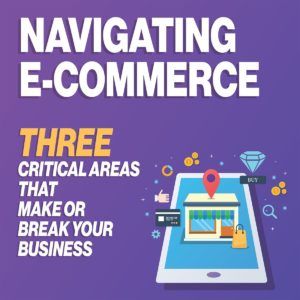Investing in Your Online Store
Think about how your website has evolved over the years. Your first website was probably like a brochure, a brief overview about you, where you are located, and the products you offer. The next phase was more like a catalogue with a selection of bestselling items available for purchase.
 But as the pandemic hastened the shift for consumers to online shopping, the time is now to move beyond the catalogue paradigm and start thinking of your website as a store, advocates jewelry industry consultant Cheryl Kremkow, who spoke on the topic in a recent Plumb Club podcast sponsored by the wedding band brand, Benchmark.
But as the pandemic hastened the shift for consumers to online shopping, the time is now to move beyond the catalogue paradigm and start thinking of your website as a store, advocates jewelry industry consultant Cheryl Kremkow, who spoke on the topic in a recent Plumb Club podcast sponsored by the wedding band brand, Benchmark.
If your business website uses a system that pre-dates 2007, you’re better off using smoke signals, quips Sean McCormick, director of social media for Novell Enterprises, a division of Continental. He unpacked digital strategies in a Plumb Club podcast with the manufacturer’s in-house photographer, Sarah Siegel.
While having a website is hardly an innovation, online functionality has come a long way. McCormick says that if you haven’t updated your web site in the last five years, you are probably missing opportunity connecting with consumers to convert digital sales leads into revenue.
“Not having an up-to-date website is kind of like having your forgetful 94-year-old aunt on the sales floor,” McCormick tells, “she may be sweet, but it’s not the best for company growth.”
Ecommerce Essential
If there is one thing the current environment has shown us, you don’t have a choice to sell online. Having your inventory online is foundational just to staying relevant, underscores Chris Awad, head of marketing, and Jason Yakubovich, director of operations for MJJ Brilliant in a Plumb Club podcast dishing about innovative tools to grow your jewelry retail business.
They mention that there are ecommerce options that have built-out websites retailers can use like Shopify, Wicks and SquareSpace, with some easier than others for retailers to upload their own content, logo, colors, and images. Other types of software like WooCommerce may require outsourcing a developer to modify. Awad considers Shopify the easiest to get ecommerce up and running quickly, and seamlessly integrated with all of your social media platforms, and other useful applications needed to run your business.
Over half of America’s screen time is on mobile devices and shopping is migrating to phones just like everything else. In addition to a fast, easy-to-use website, Kremkow says that consumers want 30-day hassle free returns and free shipping. “In 2019, 63% of abandoned online carts were due to unexpected shipping costs. You could loss a $1,000 sale over $20 in shipping. Make it easy to buy something online and return it at your store or get service in person. Customers expect all of your sales channels to be connected.”
Consistent Presentation
Providing a consistent shopping experience for your customers online starts with making sure that your web store looks and feels like your brick and mortar store. “It should match your store’s unique personality and the way it is expressed through all of your customer touch points,” Kremkow advises. “Fonts, images and design for your online store should reflect your unique personality.”
To invest in making your website feel like a store, images and content that inspire and engage are key. Excellent product photographs are essential to selling online. For many products you need different angles and close-ups, as well as standard white background shots. Kremkow suggests photographing every piece on a person, as just listing dimensions does not communicate scale. Earrings and necklaces are particularly difficult to visualize wearing without model shots.
Before customers even arrive at your website or social media, they often search for something as generic as jewelry and the name of the town they are in.Customers who see an image show up in relation to a business in search results are 60% more likely to contact that business, finds MDG Advertising research, cites Kye Ehrlich, head of photography and graphic arts at The Marathon Company, in a Plumb Club podcast. In the same research, he points out that 40% of consumers immediately left websites if the images did not load properly.
 The likelihood of selling a product rises by 63% when you have a basic image, if nothing else changes, as compared to a product with no image at all, Ehrlich says, according to Ebay research. Sales double if a high-quality image is included, while conversion rates decline if a low-quality image is used, revealing consumers value quality images when making purchase decisions. In fact, one of the top reasons people return an item is that it wasn’t accurately depicted.
The likelihood of selling a product rises by 63% when you have a basic image, if nothing else changes, as compared to a product with no image at all, Ehrlich says, according to Ebay research. Sales double if a high-quality image is included, while conversion rates decline if a low-quality image is used, revealing consumers value quality images when making purchase decisions. In fact, one of the top reasons people return an item is that it wasn’t accurately depicted.
Ehrlich encourages retailers to ask their suppliers for visual collateral. “Most, if not all jewelry manufacturers have a graphics department dedicated to producing imagery and advertisements that they want you to have because it will help you sell their product. Take advantage of what they have to offer.”
In addition to quality visual media, quality content gets customers excited about products, says Anthony Marotta is vice president of marketing for Prime Art Jewelry (PAJ) in a Plumb Club podcast discussing ecommerce strategies with PAJ President Dillion Chen. “Good content is an opportunity to get fun and creative selling your items. While you want to include certain keywords that can be more likely found by search engines, the challenge is to write listings in clear, concise, straightforward language. Good copy is easy to understand. Highlight the benefits of the product, what it is going to do for the buyer — enhance their fashionability, connect with a lifestyle or emotion, or more aspirational.”
The more general your terms are — diamond pendant — the greater the traffic but the lower the conversion. The more specific you get — diamond pendant set in 14K yellow gold in scrolling design — the less traffic but a higher conversion, Chen says.
Good Service
Thinking of your website as a store also means you need to staff your web site, reminds Kremkow. “You can’t do a good job selling online without having people behind the web pages. If you don’t have someone on call to respond immediately to customer questions you’re not providing the good service consumers expect.
Kremkow advocates jewelers add Live Chat to their website if they haven’t already. “Speaking to a real person builds trust and communicates you’re a local jeweler who’s part of the community. A recent study found 79% of businesses saw an increase in customer loyalty, sales and revenue when Live Chat was implemented, as it reinforces good service.”
Like your brick and mortar store, your website has to be constantly tweaked to serve your customers well, says Kremkow. Pay attention to the same things in your online store. Which products are looked at the most? What are customers asking for in chat or search? Which pages hold their interest, which don’t? Can they find what they’re looking for easily?

